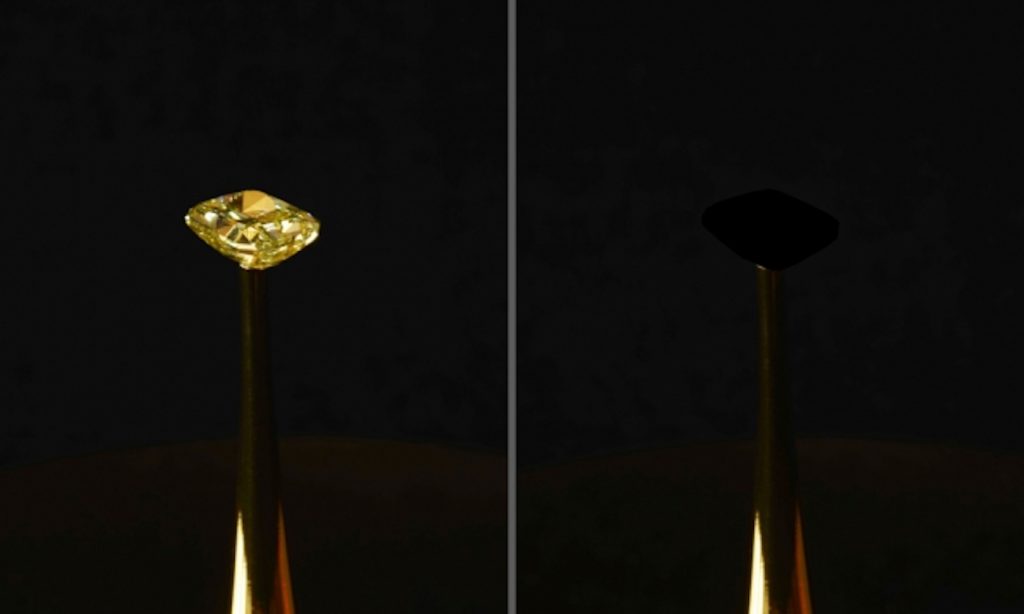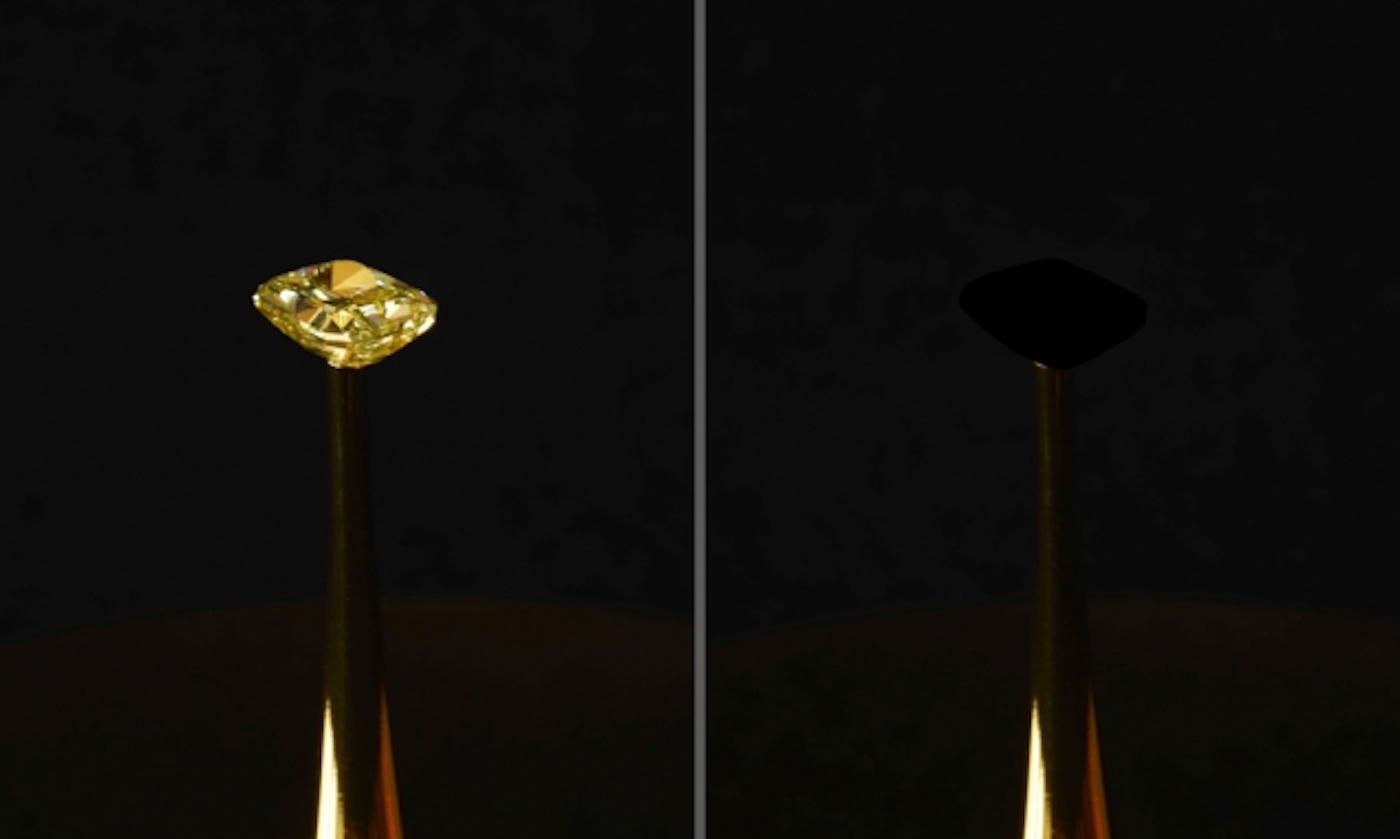
MIT engineers were delighted to report that they had accidentally cooked up a material that is 10 times blacker than anything previously recorded—and it was due to an artist’s vision for a provocative art piece that combined Greek philosophy, elemental physics, and the arbitrary value humans place on luxury items.
WATCH: Have You Ever Seen a Shaolin Monk Pierce a Pane of Glass With a Needle?
The researchers published their findings last week in the journal ACS-Applied Materials and Interfaces. But much more fascinating was the unveiling of the cloak-like material in a new art/science exhibit at the New York Stock Exchange, a place where arbitrary value is personified by the swarming hive of traders relegating value on items ranging from orange juice to gold.
Entitled “The Redemption of Vanity,” the artwork, conceived by Diemut Strebe—a German-born artist-in-residence at the MIT Center for Art, Science, and Technology—features a 16.78-carat natural yellow diamond estimated to be worth $2 million. Ms. Strebe worked for two years to try to acquire such a gem for the art piece until she found a willing partner in LJ West Diamonds.
Her idea, born in 2014, was a fusion of the Greek philosophy of Heraclitus, who revered the paradoxical nature of life, and her fascination with carbon nanotubes (CNTs), which are entirely black due to their composition of vertically-aligned microscopic filaments of carbon that act as a thick forest to block all light and shadow. Bright, sparkly diamonds, it turns out, are made of the exact same elements of carbon—just rearranged differently in their atomic lattice structure. “A gigantic opposite,” she told GNN, that inspired her to begin working on an art piece to exhibit the hidden paradox.
She wanted to completely coat a high-value stone with an ultra-black CNT material. And, inside the board room of the most famous stock exchange in the world, the effect has been regarded as sensational. Using the new breakthrough material that randomly presented itself to her scientific partners at MIT who were working on ways to grow carbon nanotubes using aluminum and salt, the new CNT material is 10 times blacker than anything that’s ever been reported—and the optics presented to invited guests in New York is arresting: The jewel, normally brilliantly faceted, appears as a flat, black void—a gem that absorbs all light.
Adding to the enchantment, Artnet reported that two large magnifying scopes were set up alongside the glass dome allowing viewers to get an even better look at the black hole where the diamond is perched.
A press release noted that the diamond cloaking is viewable by invitation only, until November 25.
Brian Wardle, the professor of aeronautics and astronautics at MIT who made the discovery, says the CNT material, aside from making an artistic statement, may also be of practical use in reducing unwanted glare in space telescopes.
LOOK: World’s Coolest Library Opens in China and It’s Breathtaking
The Accidental Discovery
Wardle and his co-author on the paper—former MIT postdoc Kehang Cui—didn’t even intend to engineer an ultra-black material. Instead, they were experimenting with ways to grow carbon nanotubes on electrically conducting materials such as aluminum, to boost their electrical and thermal properties, according to MIT news.
At the time, Wardle’s group was using salt and other pantry products, such as baking soda and detergent, to grow the nanotubes. In their tests with salt, Cui noticed that chloride ions were eating away at aluminum’s surface and dissolving its oxide layer.
MORE: Researchers Drop Ice Chunk Down Glacial Hole and it Makes the Most Satisfying Sound Ever
The team had been working with Ms. Strebe on her art project, so he immediately noticed the change in the material’s color.
“I remember noticing how black it was before growing carbon nanotubes on it, and then after growth, it looked even darker,” Cui recalls. So he measured the optical reflectance of the sample.
“Our group does not usually focus on optical properties of materials, but this work was going on at the same time as our art-science collaborations with Diemut, so art influenced science in this case,” says Wardle.
WATCH: Why the World’s Best Mathematicians Are Apparently Hoarding Chalk Made Out of ‘Angel Tears’
Cui measured the amount of light reflected by the material, not just from directly overhead, but also from every other possible angle. The results showed that the material absorbed at least 99.995 percent of incoming light, making it the blackest material on record. In other words, it reflected 10 times less light than all other superblack materials, including Vantablack, which had been previously considered for use in the art project.
“If the material contained bumps or ridges, or features of any kind, no matter what angle it was viewed from, these features would be invisible, obscured in a void of black,” wrote MIT News.
LOOK: Diver is Awestruck By Huge Jellyfish Encounter Off the British Coast
“The researchers aren’t entirely sure of the mechanism contributing to the material’s opacity, but scientists believe that forests of carbon nanotubes can trap and convert most incoming light to heat, reflecting very little of it back out as light.”
Wardle and Cui have applied for a patent on the technology, but are making the new CNT process freely available to any artist to use for a noncommercial art project—and have already been approached by several artists.
The material is already gaining interest in the aerospace community. Astrophysicist and Nobel laureate John Mather, who was not involved in the research, but who Strebe had contacted five years earlier regarding her art project, is exploring the possibility of using Wardle’s material as the basis for a massive black shade that would shield a space telescope from stray light or glare as it searches for orbiting planets.
“This black has to be tough to withstand a rocket launch,” said Mather. “Old versions were fragile forests of fur, but these are more like pot scrubbers—built to take abuse.”
The Paradoxes of the Diamond are Multi-faceted
As for the starring role of the diamond, it has at least one museum in its future, and perhaps a trip to Sotheby’s auction house, says Strebe who hoped it would provoke thought about the unification of extreme opposites—the brightest jewel and the blackest veil sharing the same elemental make-up.
The “disappearing” diamond unveiled other paradoxes, too, that Strebe alluded to in a phone call with GNN. While a literal devaluation of a $2-million diamond takes place when its apparent beauty is cloaked, the art world with its own arbitrary value judgements might even increase the gem’s value after all its glitter has been enveloped by darkness.
And, equally ironic, as the exhibit opened, some news outlets were using the photo of the ‘devalued’ gem only to highlight a scientific discovery, relegating a five-year project to the level of a sleight-of-hand stunt.
“The swallowing of the diamond caused the swallowing of the artwork,” she mused.
Be Sure And Share The Cool Discovery With Your Friends On Social Media…





















When can I expect my cloak of invisibility?